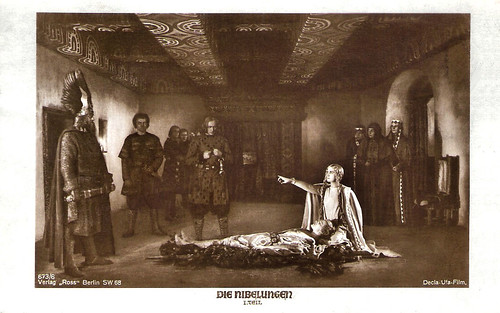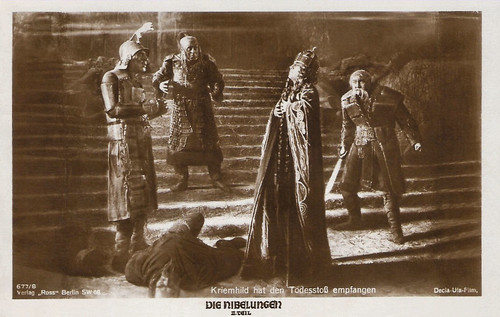
German postcard by Ross Verlag, no. 672/3. Photo: Decla-Ufa-Film. Gertrud Arnold as Queen Ute in Die Nibelungen (Frits Lang, 1924).

German postcard by Ross Verlag, no. 25/2. Photo: Ufa. Publicity still for Zur Chronik von Grieshuus/The Chronicle of the Gray House (Arthur von Gerlach, 1925). Gertrud Welcker as Gesine, Rudolf Rittner as Owe Heiken, Hanspeter Peterhans as young Enzio, and Gertrud Arnold as Matten.
Queen Ute
Gertrud Arnold was born in 1873 in Stolp, Pomerania, Germany (now Slupsk, Pomorskie, Poland). When she was 20, Arnold trained as an actress in Berlin. She had her first engagement in 1894 in Cottbus, followed by engagements in theatres in Jena, Halle and Hannover. In 1911 she reached Berlin, where she performed a.o. at the Schillertheater and the Theater am Nollendorfplatz.
Gertrud Arnold became a much-in-demand stage actress, specialising in classic roles. Memorable parts were those of Iphigenie in Goethe's 'Iphigenie auf Tauris' (Iphigenia in Tauris), Lady Milford in Friedrich Schiller's 'Kabale und Liebe' (Intrigue and Love), and Anna Mahr in Gerhart Hauptmann's 'Einsame Menschen' (Lonely people).
As of 1914 she also acted on screen. Her debut was probably in Pauline (Henri Etievant, 1914) with Alice Hechy. A unique copy of this Vitascope film was found back in the Desmet Collection of the Netherlands Filmmuseum (now Eye Filmmuseum). Between 1921 and 1930, Gertrud acted in various silent German films, mostly as the elder woman. Her most important performance was that of Queen Ute in Die Nibelungen (Fritz Lang, 1924).
After that she played Matten in Zur Chronik von Grieshuus/The Chronicle of the Gray House (Arthur von Gerlach, 1925), set in 1700 and starring Paul Hartmann, Lil Dagover, and Rudolf Forster.
Other memorable films were Im Namen des Kaisers/In the Name of the Kaisers (Robert Dinesen, 1925), the Austrian film Die Wiskottens/The Wiskottens (Arthur Bergen, 1926), Die Königin des Weltbades/The Queen of the Baths (Victor Janson, 1926) and the early sound film Rosenmontag (Hans Steinhoff, 1930) with Lien Deyers Her last film was Brand in der Oper/Fire in the Opera House (Carl Froehlich, 1931) with Gustav Froehlich. Gertrud Arnold died in Berlin-Charlottenburg in 1931. She was previously married to Heinrich Brandt.

German postcard by Ross Verlag, no. 673/6, 1919-1924. Photo: Decla-Ufa-Film. Publicity still for Die Nibelungen (Fritz Lang, 1924) with Margarete Schön as Kriemhild near the corpse of Siegfried (Paul Richter). She points at the traitor Hagen Tronje (Hans Adalbert Schlettow). Her brother, King Gunther (Theodor Loos), is standing next to her.

German postcard by Ross Verlag, no. 677/3. Photo: Decla-Ufa-Film. At the beginning of part 2 of Die Nibelungen, Kriemhild's Rache - after Siegfried has been killed by Hagen von Tronje - Margrave Rüdiger von Bechlam (Rudolf Ritttner) swears loyalty to the vengeful Kriemhild (Margarete Schön) in Fritz Lang's silent film Die Nibelungen (1924).

German postcard by Ross Verlag, no. 677/8, 1919-1924. Photo: Decla-Ufa-Film. Publicity still for Die Nibelungen 2: Kriemhilds Rache/Die Nibelungen: Kriemhild's Revenge (Fritz Lang, 1924). Kriemhild (Margarete Schön) has gotten the deathblow. In the back, King Hetzel (Rudolf Klein-Rogge) looks in astonishment.
Source: Wikipedia (German) and IMDb.
This post was last updated on 23 April 2023.
No comments:
Post a Comment